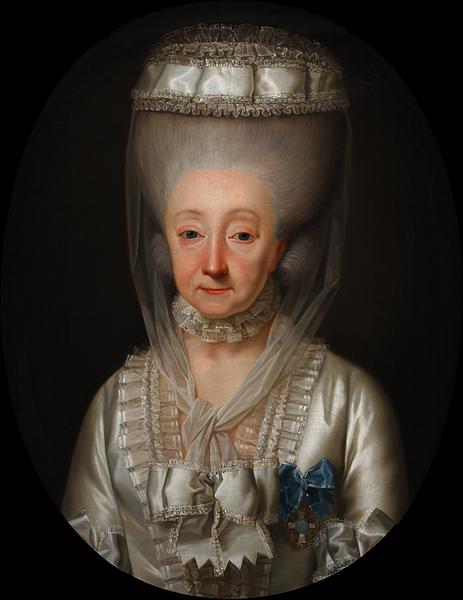Countess Charlotte Louise Scheel, née von Plessen (1720–1801), was of a prominent noble family and, together with her husband, Count Jørgen Scheel (
B 346), she was part of the inner circles of the Danish court.
[1]One specific detail in Jens Juel’s portrait particularly testifies to the countess’s exalted social status. She wears the order known as ‘de l'Union Parfaite’. It was founded by Queen Sophie Magdalene in 1732 in memory of her happy marriage to Christian VI, and the order was awarded to married couples who lived harmoniously together. The Scheels were awarded ‘de l'Union Parfaite’ in 1757, and the fact that Charlotte Louise Scheel wears the order in Juel’s portrait twenty-four years later testifies to more than ‘just’ a good marriage: the order was mainly awarded to people who were close to Queen Sofie Magdalene and Christian VI, and so it served as a status symbol and a testament to the count and countess’s strong ties to the Danish royal house.
In addition to ‘de l’Union Parfaite’, the countess’s appearance and clothes also bear witness to her rank and status: her dress and headdress are made of silk fabric and lace, which Juel has treated with great colouristic virtuosity also evident in delicate, transparent veil that extends from the headdress down to the chest, where it comes together in loose knot above the bow. Furthermore, Charlotte Louise Scheel’s hair is built up high according to the fashion of the time, and her gaze meets the viewer with a hint of a smile.
Another version of Charlotte Louise Scheel’s portrait and its counterpart can be found at the Gammel Estrup manor, where the Scheels lived for more than forty years.
Lent to the exhibitionJens Juel – Under the skin
Kunstmuseum Brandts, Odense, DanmarkFebruary 8 - August 24, 2025
Fuglsang Kunstmuseum, Toreby L., DenmarkSeptember 11, 2025 – January 18, 2026
Ribe Kunstmuseum, Ribe, DenmarkFebruary 7 - May 28, 2026
